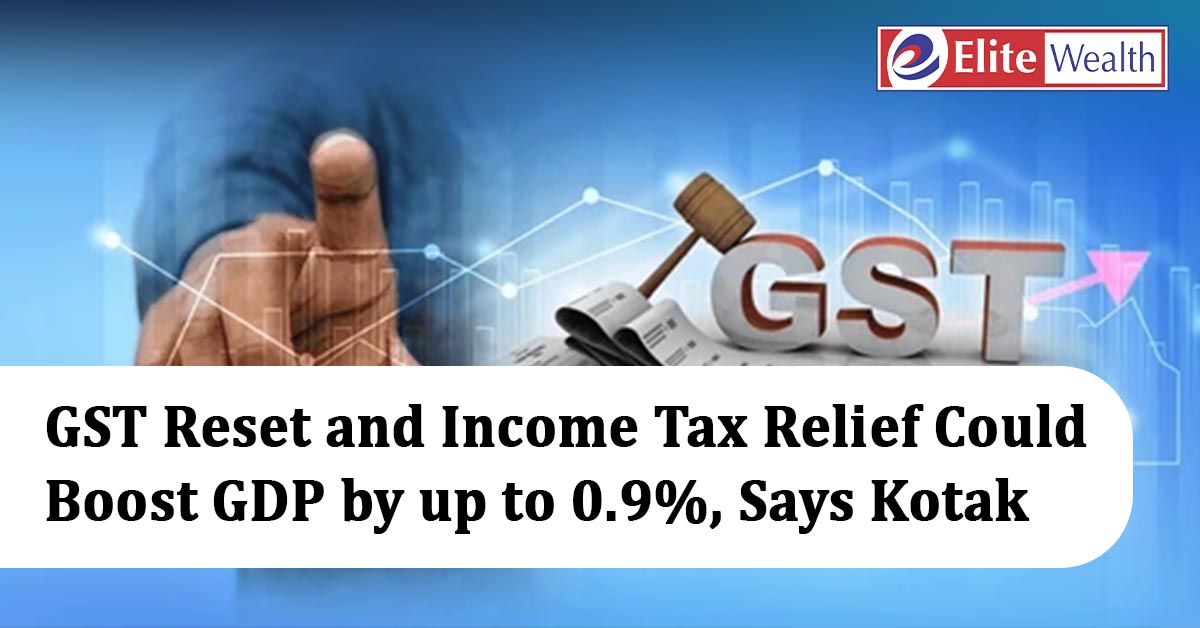
The recent GST rationalisation and income tax adjustments are expected to deliver a strong boost to India’s economy, potentially lifting GDP growth by 0.7–0.9% on an annualised basis, according to a note by Kotak Institutional Equities. The move, effective September 22, is likely to expand household purchasing power and ease macroeconomic headwinds, while keeping fiscal pressures manageable.
Revenue Implications and Fiscal Balance
Kotak’s estimates suggest that lower GST rates could result in a revenue loss of around ₹93,000 crore. However, this will be partly offset by approximately ₹45,000 crore in additional revenues from the newly introduced 40% tax slab on luxury and sin goods.
The abolition of the compensation cess on most products further reduces the tax burden, translating into an annualised household benefit of nearly ₹1.8 trillion, equivalent to 0.6% of GDP.
After accounting for these adjustments, Kotak calculates the net GST impact at about ₹48,000 crore on the FY24 consumption base, which it believes will not derail the Centre’s fiscal deficit targets. This could also ease recent volatility in government bond yields.
Market and Consumer Impact
Equity markets have already begun factoring in the reforms, with several consumer-linked stocks seeing re-rating on expectations of stronger demand. The simplified GST structure, which compresses most rates into 5% and 18%, with a 40% slab reserved for high-end goods, is expected to benefit mass-market consumption the most.
- Winners: Two-wheelers, entry-level passenger vehicles, major consumer durables, staples, and health insurance—all of which now fall under lower effective tax brackets.
- Limited Impact: Heavy materials such as cement are unlikely to see major tax relief.
- Exceptions: Tobacco products will continue to attract the compensation cess until outstanding borrowing-linked obligations are cleared, likely by the end of 2025.
Critical Timing for the Economy
Kotak underlined that the timing of this reform is crucial. So far in FY26, nominal private final consumption expenditure has grown only 9.2% year-on-year, reflecting weak consumer momentum. Additionally, elevated US tariffs are estimated to have shaved off about 0.3% from GDP growth.
The GST reset and income tax relief measures are expected to cushion this weakness, directly supporting household demand and stimulating consumption in the coming months.
Summary
- Kotak Institutional Equities estimates the GST and tax reset could lift GDP growth by 0.7–0.9% annually.
- Net GST revenue loss projected at ₹48,000 crore, manageable within fiscal deficit targets.
- Households to gain nearly ₹1.8 trillion annually, or 0.6% of GDP, from reduced tax burden.
- Mass-market goods like two-wheelers, small cars, consumer durables, and health insurance benefit most, while luxury and sin goods face 40% GST.
- Reform comes at a critical juncture, expected to offset slowing consumption and global trade headwinds.
Disclaimer:
This article is intended solely for educational and informational purposes. The securities or companies mentioned are provided as examples and should not be considered as recommendations. Nothing contained herein constitutes personal financial advice or investment recommendations. Readers are advised to conduct their own research and consult a qualified financial advisor before making any investment decisions.
Investments in securities markets are subject to market risks. Please read all related documents carefully before investing.
